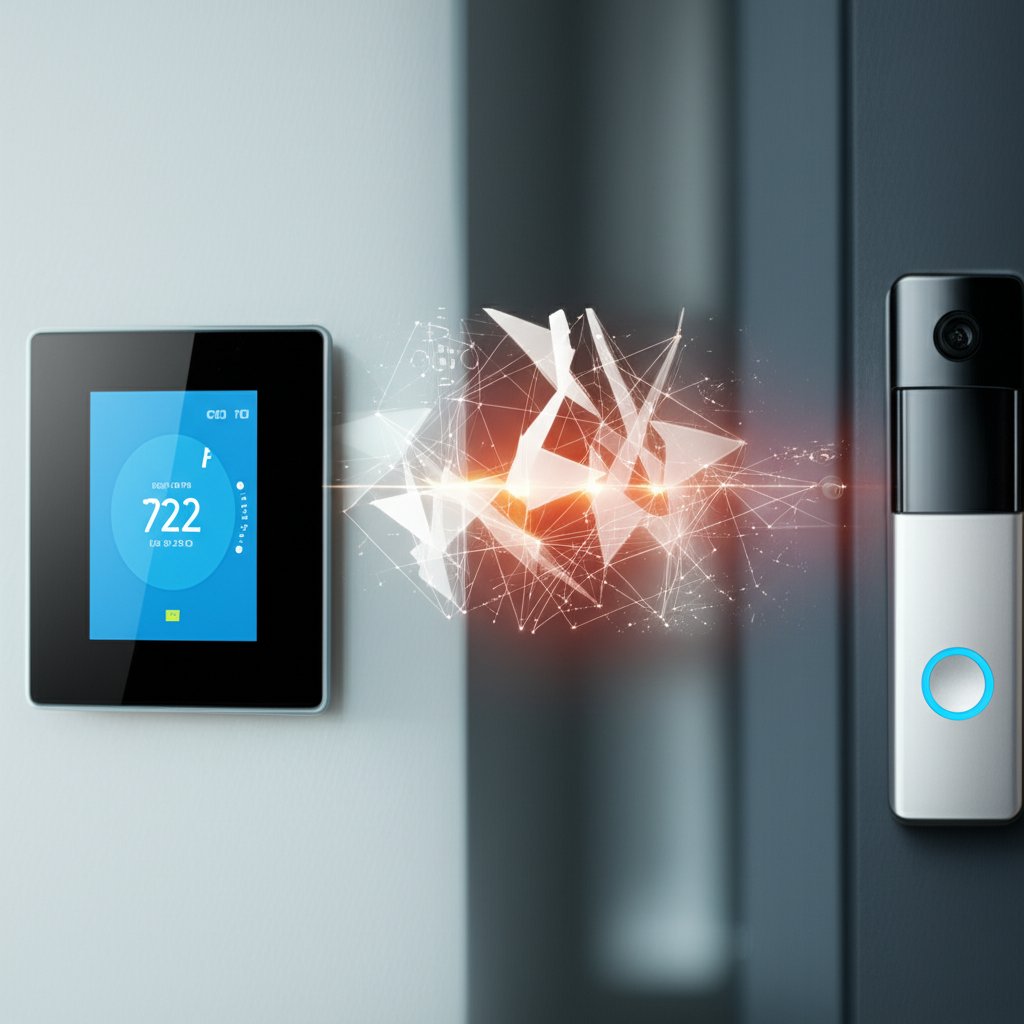How to Build a Smart Home Threat Model: Your Proactive Guide to Digital Security
Your smart home offers unparalleled convenience. With a simple voice command, you can dim the lights, lock the doors, or check in on your pets. It’s truly amazing, isn’t it? But beneath that sleek surface of automation and connectivity lies a silent, growing threat: cyber vulnerabilities. As security professionals, we recognize that while we embrace the future of living, we cannot afford to overlook the digital risks that accompany it.
Why does “before it’s too late” matter so much here? Because the number of smart home hacks and privacy breaches is unequivocally on the rise. We’ve seen everything from hijacked cameras streaming private moments to compromised locks granting unauthorized access. The truth is, waiting for something bad to happen before you act is a reactive approach that leaves you unnecessarily vulnerable. That’s why threat modeling is so crucial.
So, what exactly is
smart home threat modeling, simplified for everyday users? It’s a proactive way to think like an adversary to protect your home. Essentially, you’re asking two key questions: “What could possibly go wrong here?” and “How can I stop it?” It sounds technical, but trust me, it doesn’t have to be complicated. This guide will walk you through a practical, non-technical approach to securing your connected life, helping you secure your digital sanctuary and protect your peace of mind.
Understanding Your Smart Home’s Digital Footprint
Before you can defend your smart home, you’ve got to know what you’re defending. Think of it like mapping out your physical house before fortifying it. You wouldn’t just randomly put up walls, would you? The same applies digitally. You’re building your home’s digital footprint – understanding its layout, its connections, and its vulnerabilities.
Step 1: Inventory Your Devices
First things first, let’s take stock. Grab a pen and paper, or open a spreadsheet – whatever works best for you. Your goal is to list every single internet-connected device in your home. Don’t miss anything! We’re talking:
- Smart speakers (e.g., Amazon Echo, Google Home)
- Smart cameras (indoor, outdoor, video doorbells)
- Smart thermostats
- Smart locks and garage door openers
- Smart light bulbs, switches, and dimmers
- Smart plugs and power strips
- Smart appliances (e.g., refrigerators, ovens, washing machines)
- Robotic vacuums
- Gaming consoles and smart TVs (yes, these count!)
- Any other device that talks to the internet or other devices on your home network
Once you’ve got your list, consider how these devices communicate. Do they primarily use Wi-Fi, Bluetooth, Zigbee, or Z-Wave? How do they talk to each other, and how do they connect to the wider internet? Mapping these connections helps you visualize the pathways an attacker might exploit.
Finally, identify the data they collect. This is critical. Does your camera stream video? Does your voice assistant record audio? Does your thermostat track your daily schedule and location? Are your smart plugs logging usage patterns? Understanding what information these devices gather is the first step in knowing what could potentially be exposed or misused.
Step 2: Identify Sensitive Data & Assets
Now, let’s talk about what you’re truly trying to protect. What’s most valuable to you in your smart home environment? It’s more than just the devices themselves. We are often trying to protect:
- Your privacy (conversations, daily routines, personal images, location data)
- Your financial data (if linked to smart shopping or payment apps)
- Home access and physical security (smart locks, garage door openers)
- Your peace of mind and sense of safety
- The safety and well-being of your family members
Consider the impact if these assets were compromised. What would it mean for you and your family if your smart lock failed or your private camera footage went public? Thinking through these potential consequences highlights why proactive security isn’t just a suggestion; it’s a necessity for safeguarding your sanctuary.
Thinking Like a Hacker (Simplified Threat Identification)
Alright, it’s time to put on your hacker hat. Don’t worry, we’re not doing anything illegal here; we’re just shifting our perspective. Threats are simply “bad things that could happen.” By understanding common attack methods, you can anticipate vulnerabilities.
Step 3: Identify Common Smart Home Attack Vectors
Cybercriminals aren’t always masterminds pulling off elaborate heists. Often, they go for the low-hanging fruit. Here are some of the most common ways smart homes are breached:
- Weak Passwords/Default Credentials: This is arguably the easiest entry point. Many devices ship with easily guessable default passwords (e.g., “admin,” “password,” “12345”) that people rarely change. If you don’t change it, someone else will find it and exploit it.
- Outdated Software/Firmware: Just like your phone or computer, smart devices need updates. These updates often patch critical security flaws. If you ignore them, you’re leaving a gaping hole for attackers to exploit, similar to leaving your front door unlocked.
- Insecure Wi-Fi Networks: An open Wi-Fi network or one with weak encryption (like WEP, which is ancient and easily broken) is an open invitation for trouble. Even a strong network can be compromised if its password is easy to guess or it uses outdated protocols.
- Privacy Invasion by Design: Sometimes, the “attack” isn’t a hack, but the device itself doing too much. Devices collecting and sharing more data than necessary, or without clear consent, can be a major privacy concern, even if it’s “intended” functionality.
- Remote Access Vulnerabilities: Features designed for your convenience, like accessing your camera feed or adjusting your thermostat from anywhere, can sometimes be exploited if not properly secured. A weak login or an unpatched vulnerability in the remote access feature can grant unwanted entry.
- Physical Tampering: While less common for purely software threats, some devices like smart locks or outdoor cameras can be physically tampered with if an attacker gains access to your property. This might involve attempting to physically bypass the lock or remove a camera.
Step 4: Brainstorm “What If” Scenarios
This is where we get specific. Let’s run through some “what if” scenarios based on your device inventory and the assets you identified. Ask yourself these questions:
- What if my smart camera is hacked? Someone could spy on your family, monitor your empty home for burglary, or even speak through its two-way audio feature, causing distress or impersonation. This is a serious invasion of privacy and a potential physical security risk.
- What if my smart lock is compromised? An unauthorized person could gain entry to your home, putting your family and possessions at severe risk. This directly impacts physical safety and property security.
- What if my voice assistant records private conversations? This sensitive audio data could be stored, analyzed, or even leaked, revealing personal details about your life, habits, and potentially sensitive information about your family or finances.
- What if my smart thermostat is manipulated? Imagine your energy bills skyrocketing unexpectedly, or your home becoming uncomfortably hot or cold, all without your control. While less severe, it’s an impactful inconvenience and can lead to significant financial loss.
- What if my home network is breached? This is a cascading threat. If your Wi-Fi network security fails, an attacker could potentially gain access to all your connected smart devices, creating a widespread cascade of vulnerabilities across your entire digital home. You can learn more about these risks in our article on Smart Home Security Risks.
Don’t just stop at these examples. Go through your list of devices and imagine the worst-case scenario for each, considering both the common attack vectors and your specific sensitive assets. It’s not about being paranoid; it’s about being prepared.
Assessing Risk: How Bad Could It Be?
Now that you’ve identified potential threats, it’s time to assess the risk. In simple terms, “risk” is a combination of two things: how likely something is to happen, and how much damage it would cause if it did.
Step 5: Determine Likelihood – How Easy Is It?
Think about each “what if” scenario and try to estimate its likelihood. How easy or probable would it be for that threat to actually occur?
- If you’re still using default passwords on devices, the likelihood of a compromise is incredibly high. It’s not a matter of if, but when.
- If your Wi-Fi network has a weak, easily guessable password, that’s also high likelihood.
- If you never update your devices, the likelihood of an exploit is much higher than if you’re diligent about patching.
- If you’ve implemented strong security measures, the likelihood of a successful attack against those specific points becomes much lower.
Be honest with yourself here. This isn’t about shaming; it’s about realistic assessment to guide your defensive efforts.
Step 6: Determine Impact – How Much Damage?
Next, consider the impact. If the threat did materialize, how much damage would it cause? This isn’t just financial. It’s about privacy, safety, and inconvenience too.
- A smart lock hack? High impact – potential for physical harm, theft, and profound loss of safety.
- A smart light bulb being manipulated (e.g., turning on/off randomly)? Low impact – mostly an annoyance, though could be unsettling.
- Voice assistant recording and leaking private conversations? High impact – significant privacy breach, potential for social engineering or identity theft.
- Smart thermostat manipulation? Medium impact – financial cost, discomfort, but generally not a physical safety risk.
Step 7: Prioritize Risks
With likelihood and impact in mind, you can now prioritize your efforts. Focus your energy first on threats that are both high likelihood AND high impact. These are your critical vulnerabilities that need immediate attention. Don’t stress too much about low-likelihood, low-impact issues right away. We’re looking for the biggest bangs for the hacker’s buck, and how to stop them from happening in your home.
Building Your Defenses (Mitigation Strategies)
This is the empowering part – the “how to fix it” section. Once you know what’s at risk, you can put specific defenses in place. This isn’t just about reacting; it’s about building a strong, resilient smart home.
Step 8: Implement Foundational Security Practices
These are your non-negotiables, the bedrock of any solid smart home security plan:
- Strong, Unique Passwords & Password Managers: Every single device, every single online account connected to your smart home, needs a strong, unique password. Period. Use a reputable password manager (e.g., LastPass, 1Password, Bitwarden) to generate and securely store these complex passwords so you don’t have to remember them all. While focusing on strong passwords, consider exploring passwordless authentication as the future of identity management for even greater convenience and security in the long run.
- Multi-Factor Authentication (MFA): Where available, enable MFA. This means that even if someone manages to get your password, they would still need a second form of verification (like a code from your phone, a fingerprint, or facial recognition) to log in. It’s an essential, robust layer of defense. For a deeper understanding of advanced identity solutions, explore whether passwordless authentication is truly secure.
- Regular Software & Firmware Updates: Make it a habit. Check for updates for all your smart devices, your router, and any smart home hubs frequently. Enable automatic updates if possible. These updates often contain critical security patches that close known vulnerabilities. Treat these updates as urgent; they are your digital immune system.
- Secure Your Wi-Fi Network: Your Wi-Fi is the gateway to your smart home. Ensure it has a strong, unique password. Use WPA2 or, even better, WPA3 encryption. Change the default SSID (network name) to something generic that doesn’t identify your home or personal information. Disable WPS (Wi-Fi Protected Setup) if your router allows it, as it’s often a vulnerability. For more comprehensive advice on securing your home network, including best practices for all connected devices, consult our guide.
Step 9: Adopt Advanced Smart Home Security Measures
Once you’ve got the basics down, consider stepping up your game with these more advanced techniques:
- Network Segmentation (Guest Networks/VLANs): This is a powerful technique. Create a separate guest network specifically for your smart devices. This isolates them from your main network where your computers, phones, and sensitive files reside. If a smart device is compromised, it can’t easily jump to your primary devices, significantly limiting the damage.
- Disable Unused Features & Remote Access: If you don’t need a feature, turn it off. Many devices come with remote access enabled by default. If you don’t use it, disable it. Less functionality means a smaller “attack surface” for hackers to exploit.
- Research Before You Buy: Before adding a new device to your home, do your homework. Look for reputable brands with a track record of good security and privacy practices. Read reviews, check for regular software updates, and meticulously understand their privacy policies. Avoid “no-name” brands that might cut corners on security.
- Review Privacy Settings: Dive into the settings of each smart device and its associated app. Limit data collection and sharing wherever possible. Understand exactly what data is being collected and why, and opt out where you can.
- Monitor Your Network: Consider using network monitoring tools (some advanced routers have them built-in, or third-party solutions exist) to keep an eye on connected devices and flag any unusual activity or unrecognized devices. Knowing what’s connected to your network is half the battle.
Step 10: Create and Follow Your Personalized Smart Home Security Plan
To keep things actionable and ensure continuous protection, formalize your threat modeling efforts into a personalized checklist you can review periodically. This is your living document for a secure smart home:
- Inventory: List all smart devices, their communication methods, and the data they collect.
- Assets: Identify the most sensitive data and assets tied to each device (e.g., privacy, physical access).
- Threats: Brainstorm “what if” scenarios for each critical device, considering common attack vectors.
- Risk Assessment: Assess the likelihood and impact of each scenario.
- Prioritization: Prioritize high-likelihood, high-impact risks for immediate action.
- Passwords & MFA: Implement strong, unique passwords and Multi-Factor Authentication (MFA) wherever possible for all accounts and devices.
- Updates: Schedule and perform regular firmware/software updates for all devices and your router. Enable automatic updates if feasible.
- Network Security: Secure your Wi-Fi network with strong encryption (WPA3/WPA2) and a complex password; disable WPS.
- Segmentation: Consider network segmentation (e.g., a dedicated guest network) for your IoT devices.
- Privacy: Regularly review and adjust privacy settings for all devices and associated apps to limit data collection.
- Research: Thoroughly research new devices for security and privacy practices before purchase.
Conclusion
Building a smart home threat model doesn’t have to be an intimidating, overly technical process. It’s really about cultivating a proactive mindset, understanding your unique digital landscape, and taking deliberate, systematic steps to secure it. You’re not just buying gadgets; you’re integrating technology into the very fabric of your home life, and that deserves careful, professional-level consideration.
You have the power to secure your digital home. By thinking critically about what could go wrong and applying these practical mitigation strategies, you’re transforming your smart home from a potential vulnerability into a fortified sanctuary. Don’t wait for a breach to happen. Start your smart home threat model today and take control of your digital security.









